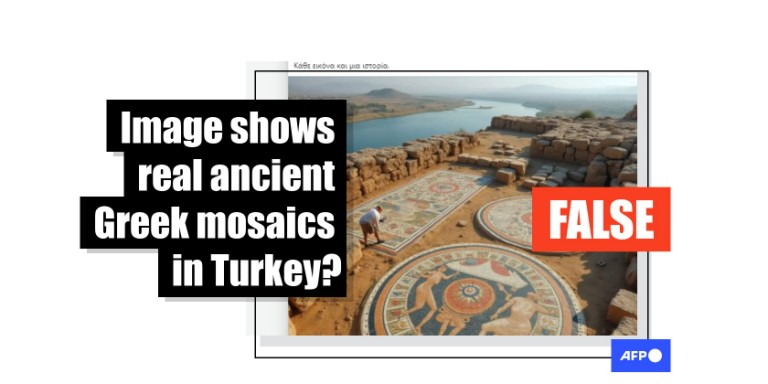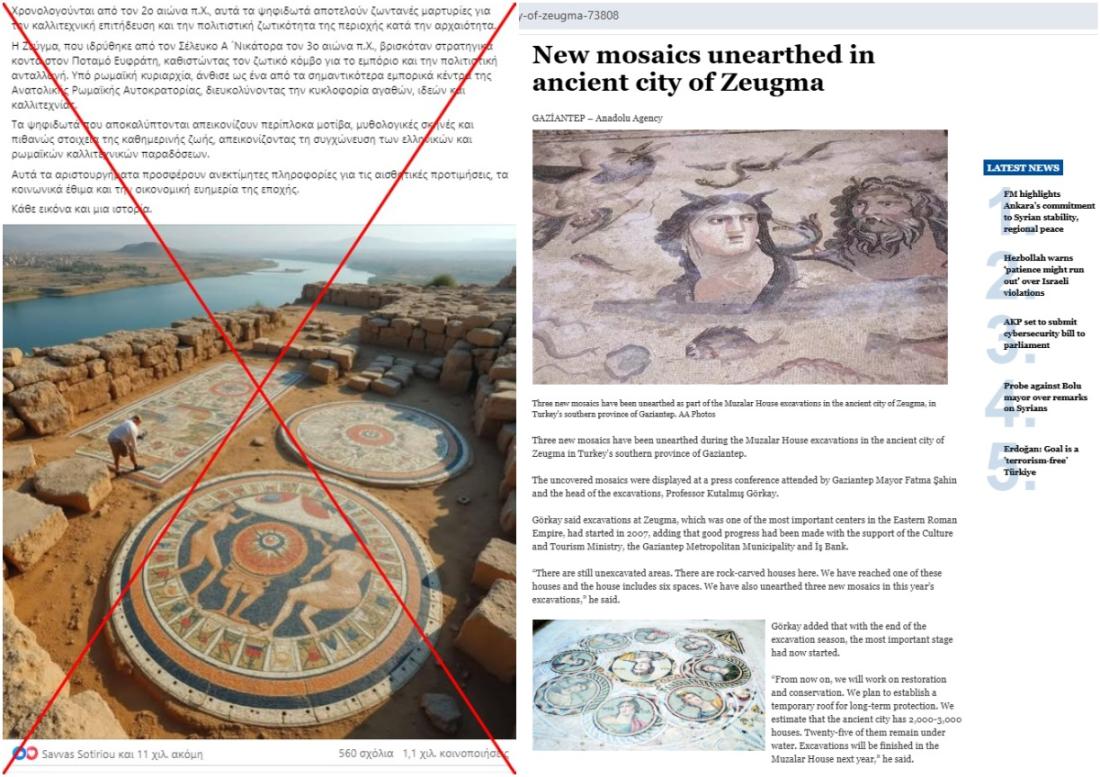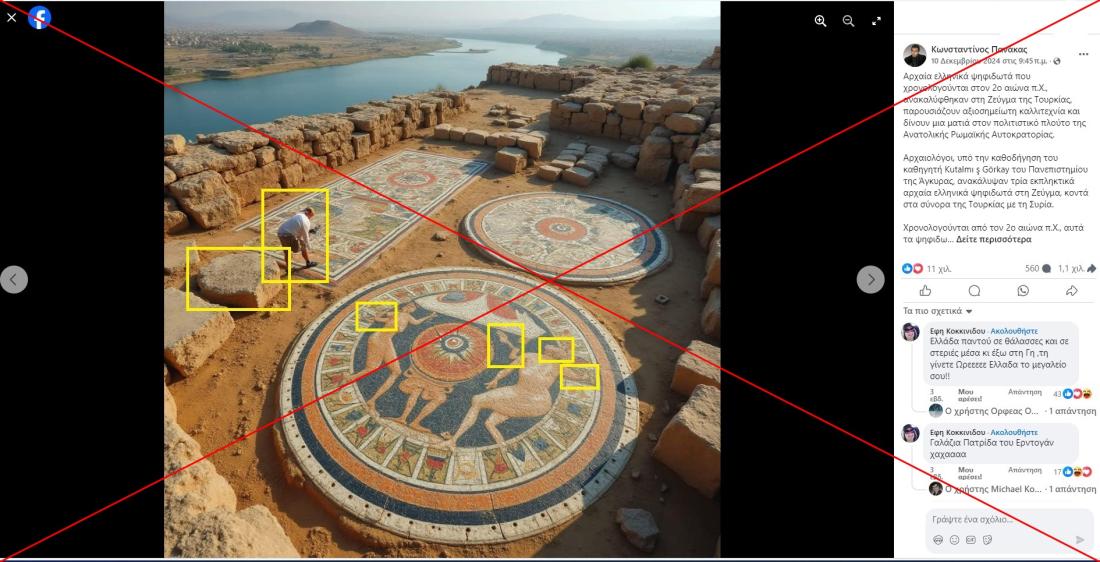
Experts confirm image showing ancient Greek mosaics is fake, likely AI-generated
- Published on January 13, 2025 at 17:58
- 5 min read
- By Magdalini GKOGKOU, AFP Greece
Zeugma is an ancient city in eastern Turkey renowned for its cultural heritage and archaeological sites. In early December 2024, a photo began circulating on Greek social media, falsely claiming to show Greek mosaics from the second century BC discovered in Zeugma. However, three archaeological experts - including a professor mentioned in the post - explained that the mosaics in the image cannot be real. The Zeugma Mosaic Museum also confirmed that the pictured artwork is not part of their collection. Moreover, artificial intelligence (AI) experts contacted by AFP used detection tools to identify signs suggesting the images were possibly AI-generated.
"Ancient Greek mosaics dating back to the 2nd century BC, discovered in Zeugma, Turkey, show remarkable artistry and provide a glimpse into the cultural wealth of the Eastern Roman Empire," reads this Facebook post from December 10, 2024, which has since been shared more than 1,100 times.
The post features a photo of mosaics on a hilltop overlooking a river portraying what appear to be mythological scenes.
"Archaeologists, under the guidance of Professor Kutalmı ş Görkay of Ankara University, have discovered three stunning ancient Greek mosaics in Zeugma, near Turkey's border with Syria," continues the post.
The same claim with the photo was shared on Facebook (here and here), X (here), and this Greek website.
Beneath the posts, many users share nationalistic and patriotic sentiments, leaving comments like "Greece is everywhere, in seas and on land, both within and beyond the Earth," or "Wherever you lift a stone, you will find Greece."
The ancient city near Belkis in Turkey's Gaziantep Province is home to the Zeugma Mosaic Museum, which features a large collection of Roman and Late Antique mosaics and other artefacts. In December 2024, Turkish media reported that Zeugma's House of Muzalar, famous for its mosaics, will open to visitors in 2025.
However, although Zeugma is renowned as a significant archaeological site, the photo circulating on Greek social media does not show a real discovery.

Archaeologists explain that the image cannot be real
AFP contacted Doctor Kutalmis Görkay, the archaeologist mentioned in the Greek posts, to ask if he discovered mosaics in the image and whether their colours and designs could align with those from the 2nd century BC.
Görkay confirmed that he had not uncovered the pictured artwork, calling the information circulating on social media "fake news" in a January 3, 2025 email to AFP.
AFP also contacted the director of the Zeugma Mosaic Museum who confirmed that the mosaic is not part of their collection on January 8, 2025.
Gorkay added that he thought the image was "AI-generated", saying that "one can easily understand when one looks at carefully the mosaics and the architectural remains in style and scale wise".
AFP contacted other archaeology specialists who confirmed Gorkay's expert opinion that the pictured mosaics do not show realistic artefacts from ancient Greece.
"This photo is very bizarre," said Ruth Westgate, a Senior Lecturer in Ancient History and Archaeology at Cardiff University on January 8, 2025.
"There's no way that the mosaics are real - they look nothing like real Roman mosaics," she told AFP, explaining that although Zeugma was a Greek city, the mosaics found there today are actually from Roman times.
She then explained that everything about them is historically inaccurate.
"They don't appear to be made with tesserae (mosaic cubes), and normally the pavement would cover the whole floor of the room, extending to the base of the walls, rather than forming isolated shapes in the middle of the room," she said.

"The figures are very oddly proportioned and flat - the real mosaics at Zeugma are very naturalistic and painterly. Figured scenes are normally framed by multiple concentric borders with repeating geometric patterns or lush plant motifs. I've never seen anything like the figure in the middle of the foreground 'mosaic' with the giant eye standing on human legs," she added.
"I cannot imagine anything that looked less like genuine ancient mosaics, of whatever date, than these three works," Katherine Dunbabin, Professor Emerita in Greek and Roman studies at McMaster University in Canada, told AFP on January 8, 2025.
The image is an "absurd fabrication", she added.
She noted that the images in the mosaics are "very obviously modern", and they do not even pretend to "look ancient" or "bear any resemblance to any Graeco-Roman art".
"As for the photo, it looks as though the setting was supposed to be on the Euphrates downstream from the site of Zeugma (if the mound on the left-hand bank further up is meant to be the acropolis, Belkis Tepe), but since 2000 that area has been occupied by the dam and the reservoir behind it. It looks as though an old photo from before 2000 has been used to set the scene," she explained.
"A quick answer is that these objects are emphatically not genuine ancient mosaics, and no one should think they might be", Dunbabin added.
Görkay told AFP he intends to file a formal complaint letter to "the General Directorate of Antiquities of the Ministry of Culture and Tourism" in Turkey.
AI detection suggests the image may be AI-generated
AFP also sent the image to two AI experts to get their opinions.
V.S. Subrahmanian, Professor of Computer Science at the McCormick School of Engineering at Northwestern University, analyzed the image using "five deepfake detection algorithms to predict whether it is more likely to be real or more likely to be fake".
After running five predictive models, the report showed that two models found the image was likely AI-generated with a probability above 0.5 but could not say definitively.
However, a human analyst said that "there are several indicators that the image may be inauthentic", such as the person depicted in the image who appears to be likely deformed, with disproportionate physical proportions. "Given the lighting conditions, we would expect the person's shadow to be visible in the image", the report states.
According to the report, the mosaic has some potential inconsistencies, including a deformed hand, an incomplete head, and a partially missing hand.

Olga Papadopoulou, a research assistant at the Centre of Research & Technology Hellas, also evaluated the image using a tool called "Synthetic Image Detection", which includes several models designed to detect synthetic images.
"The SPAI model finds the image to be synthetic with a value of 99.99%", while two other models find the image as synthetic with 68.28% and 68.87%, respectively," she explained to AFP on December 18, 2024.
AFP was not able to find the source of the image.
Copyright © AFP 2017-2025. Any commercial use of this content requires a subscription. Click here to find out more.
Is there content that you would like AFP to fact-check? Get in touch.
Contact us




